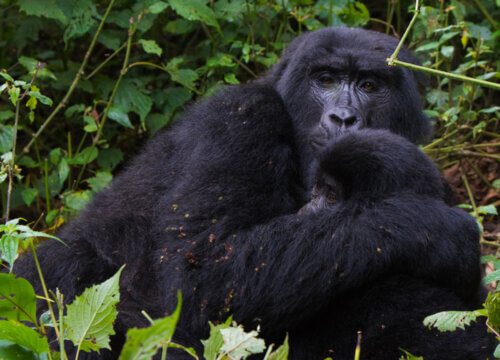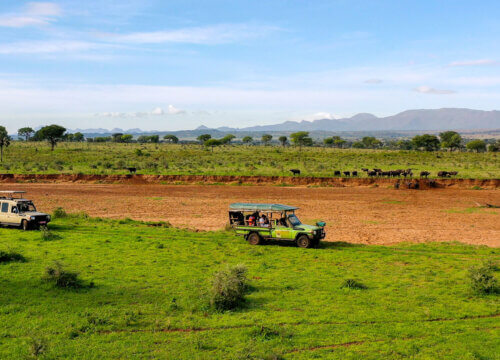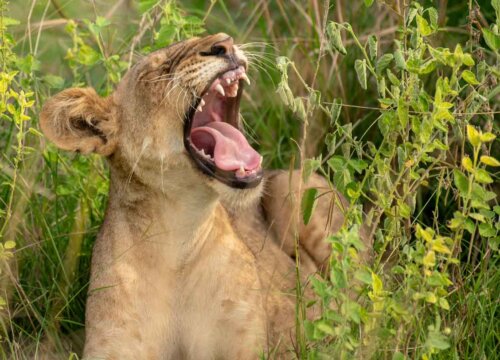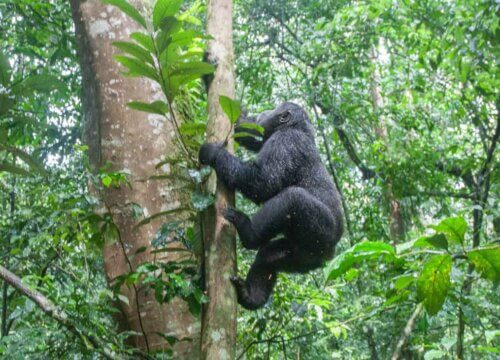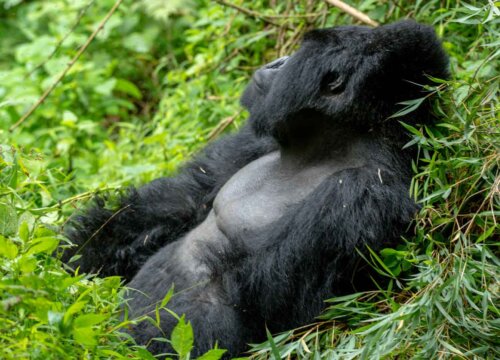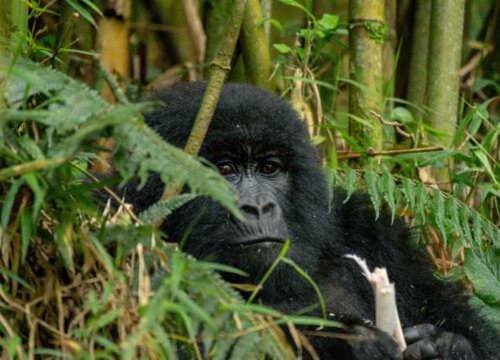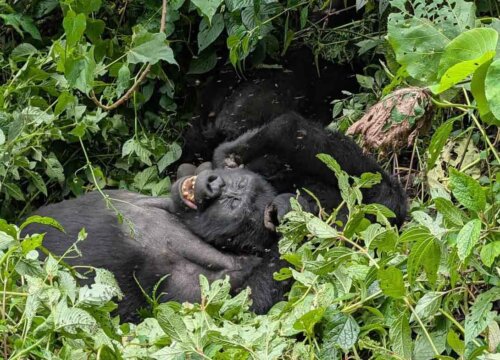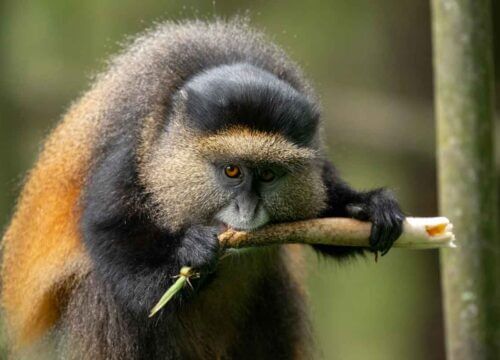Best Price for gorilla permits in Bwindi and Mgahinga
Best Price for gorilla permits in Bwindi and Mgahinga
Uganda Wildlife Authority (UWA) sets the official price for gorilla permits which grants you access to mountain gorillas in Bwindi Impenetrable Forest National Park and Mgahinga Gorilla National Park. For foreign non-residents, permits cost 800 USD per person, foreign residents pay 700 USD and East African citizens enjoy a discounted rate of UGX 300,000. Gorilla habituation permits cost 750,000 UGX for East African citizens, 1000 USD for foreign residents and 1500 USD for foreign-nonresidents. These prices apply to both Bwindi and Mgahinga ensuring a transparent fee structure. To secure the best deals, book your permit in advance because their demand is high especially during peak trekking seasons of June to September and December to February. Working with a trusted tour operator like Giant Holiday Safaris can also simplify the process and help you plan your adventure without hassle. Both Bwindi and Mgahinga give unique gorilla trekking experiences. Bwindi Impenetrable Forest National Park is home to more than 21 gorilla trekking families across its four sectors while Mgahinga Gorilla National Park has a more private trek with one gorilla family and few visitors. For gorilla habituation, it is done in the southern sector of Bwindi Impenetrable Forest National Park.
How to book Gorilla trekking permits in Mgahinga and Bwindi Impenetrable Forest National Park.
Booking gorilla trekking permits for Mgahinga Gorilla National Park and Bwindi Impenetrable Forest National Park in Uganda is a simple process but it is important to plan ahead since permits are limited and their demand is high. First, decide on the number of people you wish to travel with, your preferred park and trekking date. Mgahinga has one habituated gorilla family while Bwindi has more than 21 gorilla trekking sectors, each with unique terrain and gorilla groups. Once you know your choice, contact Giant Holiday Safaris, a trusted tour operator to secure your permit. Upon confirming permit availability from Uganda Wildlife Authority, you will be contacted by our tour operator to make payment. You are asked to forward details like your full name a presented on your passport, nationality, date of birth and passport expiry date.
What does a gorilla permit fee cater for in Mgahinga and Bwindi Impenetrable Forest National Park
Gorilla trekking and gorilla habituation permits give visitors a unique opportunity to spend up to one hour with a habituated gorilla family, cover park entry fees, government tax, trekking certificate and the services of experienced park rangers and guides who ensure your safety and provide valuable insights about the gorillas and their home. Additionally, the fee contributes to the conservation efforts aimed at protecting these critically endangered species and their fragile habitats. It also supports local communities by funding projects like schools, hospitals and infrastructure which creates a positive relationship between people and wildlife. Gorilla permits do not cater for tips, transport, accommodation and personal expenses.
Can I buy Uganda gorilla permits in instalments?
Giant Holiday Safaris offers flexible payment plans. For example, we might allow you to pay a deposit of 30% for Mgahinga Gorilla National Park and 70% for Bwindi Impenetrable Forest National Park to reserve your spot and you settle the balance later. To qualify for this, you need to buy gorilla trekking or habituation permits 90 days before your trip date and remember to pay the balance before the 90-day gorilla safari day. In case you fail to clear your top up amount, you are penalized by re-opening your gorilla permit for public booking with no deposit refund. Paying in instalments makes budgeting for your trip more manageable.
Is the gorilla permit price worth that money?
Gorilla trekking and habituation permit costs are worth all that money and more because they give you a rare opportunity to see gorillas in their natural home. The permits which can be quite high depending on the country usually go towards conservation efforts, park management and supporting local communities. By 1980s, gorillas were about to get extinct but thanks to the conservationists because right now there are more than 1000 gorillas in the world according to the survey carried out by the American primatologist Dian Fossey. This price shows a huge effort required to protect gorillas whose populations are critically endangered. The funds help to minimize poaching, preserve their environment and ensure that future generations can also enjoy gorilla trekking and gorilla habituation experiences. The chance to meet face to face with wild gorillas is priceless for many tourists with unique memories, photos and stories from such a trip. In the end, whether high gorilla permit fees are worth depends on your priorities and budget. If you are passionate about wildlife and conservation, the gorilla permit is more than just a ticket, it is an investment for a better future for endangered gorillas. While on your safari, do not hesitate to consider hiring a porter at an affordable fee to assist you in carrying your luggage while trekking. This is a direct way of giving back to the community in Mgahinga Gorilla National Park and Bwindi Impenetrable Forest National Park.
Best time to book gorilla trekking and habituation permits for Mgahinga and Bwindi Impenetrable Forest National Park
The best time to book gorilla trekking and habituation permits for Mgahinga Gorilla National Park and Bwindi Impenetrable Forest National Park is as early as 6 months or 1 year in advance especially if you plan to visit during peak seasons. mountain gorilla permits are limited to ensure sustainable tourism and minimal disturbance to the animals with a minimum of 8 trekkers for gorilla trekking per gorilla family and 4 for gorilla habituation. The peak seasons from June to September and December to February have the most favorable weather conditions with less rain making trekking easier and more enjoyable.
On the other hand, if you are looking for a quiet experience and discounted rates on accommodation, consider visiting during the rainy seasons that is March to May and October to November. Note that paths may be muddy but with a greener vegetation and fewer crowds giving you a unique, private and peaceful experience.
What is the age limit for Gorilla safaris in Mgahinga and Bwindi Impenetrable Forest National Park?
The age limit for gorilla safaris in Uganda is 15 years and above because gorilla trekking and gorilla habituation trips are physically demanding with long hikes through dense forests. Along the gorilla trekking journey, you will meet rough paths, irritating plants and scary wild animals which younger children cannot withstand. In Addition, you may need to walk through soggy and slippery grounds which are not be favorable for children below 15 years. younger children might also unintentionally disrupt the calm environment required for sensitive gorillas.
The dos and don’ts of gorilla trekking safaris in Uganda
- Follow the guide’s instructions because your guide knows the area and gorillas very well which is best for a safe encounter.
- Maintain a safe distance of at least 8 meters away from the gorillas after locating them to protect them and yourself from potential harm or disease transmission.
- Keep noise levels low and avoid sudden movements to ensure a peaceful interaction.
- Do not touch gorillas because they are wild animals and physical contact can stress them or spread diseases.
- Bright flashes can frighten gorillas so use to non-flash cameras.
- Preserve the gorilla environment by taking all your waste with you.
- Volunteer to stay behind if you are sick with a communicable infection so that you do not spread it to gorillas.
- Do not feed gorillas because they are wild animals and therefore must look for their own food. This prevents them from relying on humans.
- The age limit for gorilla safaris is limited to 15 years and above because these trips are physically demanding and younger children cannot bear trekking conditions.
- Do not provoke gorillas because they are wild animals and still possess wild behaviors even if they are habituated.
- Avoid surrounding gorillas and instead stay in tight groups so that they do not feel ambushed.
- In case you want to defecate, ask your guide to dig a hole of at least 30 cm deep and cover it beyond recognition after use.
How long does a gorilla safari take in Mgahinga and Bwindi Impenetrable Forest National Park?
The duration for a gorilla safari in Uganda’s Mgahinga Gorilla National Park or Bwindi Impenetrable Forest National Park is not yet established. The time of the trek largely depends on the location of the gorilla families on the day of your visit because gorillas hold territorial fights, move to adventure, congregate to mourn the death of a gorilla family member and have their feeding points. The actual time spent trekking to find gorillas changes because they move freely in their natural home. Sometimes your trekking pace determines the time you will locate gorillas. You are required to remain patient because panicking may push them to deeper forest ends in case they are scared. Once you meet gorillas, you will have an hour to see and photograph these gorillas up close. For habituation experiences, you will spend 4 hours watching the habituation process as gorillas continue running their daily activities like combing each other’s fur, feeding, playing and more activities. This time is limited to minimize causing stress on gorillas. No matter how long your trek takes, the memories you create during this rare experience are worth and will last forever.
Are mountain gorillas dangerous?
Gorillas are intelligent creatures bulky in size with dark furry bodies and fierce looks. A fully grown male gorilla weighs about 136-227 kg and while they may seem scary due to their size and strength, they are generally not dangerous to humans if treated with respect. Gorillas are vulnerable gentle giants that like peaceful interactions within their groups and avoid conflicts whenever possible. In the forest, gorillas tend to be shy and will run into hiding if they sense intruders. However, like any wild animal, they can become defensive if they feel threatened by anyone or if they sense that their family group is in danger. Silverback gorillas who lead their groups are protective of their families and may show aggressive signs like chest-beating, loud vocalizations, walking on one foot, hooting and pulling of grass around them to warn intruders. In case you notice such behavior, do not run or panic because gorillas may attack you. let the ranger find out the root cause of the behavior and follow instructions as he leads.
Despite their calm nature, It is important to remember that gorillas are wild animals and should be observed from a safe distance of 8 meters especially in their natural homes.
Get in touch with Giant Holiday Safaris for more information about gorillas and gorilla trips.
How sure can I be to see gorillas in Mgahinga and Bwindi Impenetrable Forest National Park
Mgahinga Gorilla National Park and Bwindi Impenetrable Forest National Park are two of the best destinations for gorilla trekking in Uganda. If you are wondering how sure you can be about seeing gorillas, be rest assured that your chances are 98% very high. Both parks are home to habituated gorilla families which means the gorillas are used to being in human presence over time which makes them stay peacefully with humans for a certain time. In Bwindi, there are many gorilla families spread across its four trekking sectors of Buhoma, Nkuringo, Ruhija and Rushaga which gives trekkers a variety of trekking and gorilla viewing opportunities. Mgahinga also has a well-protected gorilla population.
Even though the nature of gorillas is wild, sightings are guaranteed because both parks have experienced guides and trackers who work tirelessly to monitor and locate gorillas every day. Guides track areas where gorillas spent their night or where they were hanging out from the previous day and use these details to currently located them so that trekkers spend less time in the forest. Other signs to look out for that indicate the nearby presence of gorillas are hooting sounds, fresh dung, footprints and freshly chewed fruits. Trekking permits help in limiting the number of visitors thus ensuring a more private and successful gorilla meeting. For more information about Gorilla experience assurance, please contact Giant Holiday Safaris.
Explorer More Safaris
- 14-Days Uganda Safari Gorilla Chimpanzees and Wildlife
- 12 Days Gorillas and Chimpanzees Wildlife Safari
- 10 days best of uganda primates & wildlife safari
- 6 Days Gorillas and Chimpanzee Trekking Safari
- 3 Day Bwindi Gorilla Trekking Safari
- 4 Day Uganda Gorilla Trekking and Wildlife Safari
- 4 Days Gorilla Trekking and Adventure Safari
- 5 Days Uganda Gorillas and Chimpanzee Tracking Safari
- 4-Day Rwanda Gorilla Trekking and Golden Monkey Tracking Safari
- 5 Day Gorilla Habituation and Chimp Trekking
- 4-Day Uganda & Rwanda Gorilla Trekking Tour
- 3 Days Bwindi Gorilla Trekking Ugnada from Rwanda
- 10 Days Uganda Primates and Game Safari

